This creamy Butternut Squash Hummus recipe is a perfect dip if you're looking for an easy appetizer at gatherings in the fall! It's also great to add to grain bowls or salads. 😊 What makes this easy homemade hummus so special is the addition of roasted butternut squash & garlic that adds so much extra flavor!

Recently, I had a couple of my best friends over for a little recipe testing evening. I made 3 different hummus recipes for appetizers and had them vote on their favorite and this Butternut Squash hummus was a clear winner! So of course I had to share the recipe with you.
As a dietitian, I'm a big fan of homemade hummus recipes like my Mediterranean hummus, protein hummus, pumpkin hummus, buffalo hummus, and Za'atar hummus. But this Butternut hummus is IDEAL If you're looking for a healthy fall snack or a flavorful dip to bring for Thanksgiving. Plus, it provides dietary fiber + vitamins A & C. 😊
Jump to:
Key Ingredient Notes and Substitution Ideas
This easy butternut squash hummus recipe is made with basic ingredients. Below are some ingredient notes. Check the recipe card at the bottom of the post for the measurements.

- Chickpeas - chickpeas (garbanzo beans) provide dietary fiber for gut health and 12g of plant-based protein per cup. To make this recipe even easier, use a can of chickpeas so that all you need to do for prep is rinse them. If you prefer to use dry chickpeas, cook and dry them before roasting.
- Butternut Squash - butternut squash is the star of the show in this hummus. To choose a ripe butternut squash, pick one that's heavy for its size. If you want to save some time use precut butternut squash.
- Fresh Garlic - you’ll be roasting a whole bulb of garlic with the butternut squash. It almost caramelizes as it roasts and it adds tons of flavor.
- Fresh Thyme - fresh thyme adds fall flavor. You can add sage leaves or rosemary too if you'd like. If you want to use dried herbs, use 1 teaspoon of dried thyme.
- Tahini - tahini is a sesame seed paste made from toasted and ground sesame seeds and it adds a nutty, earthy flavor to hummus. If you prefer a sweeter flavor or don't have tahini, you can substitute with peanut butter or almond butter.
- Lemon Juice - fresh lemon juice adds brightness and citric acid which acts as a natural preservative. Plus, it contains vitamin C which is important for your immune health!
- Maple Syrup - just a small amount to add sweetness that balances out the lemon.
- Extra Virgin Olive Oil - a little olive oil helps give this hummus a smooth texture. It also adds antioxidants and heart-healthy fats that support brain health and hormone health. You can use avocado oil if you prefer a more mild flavor.
- Ground Cumin - to add a deep earthy flavor.
- Kosher Salt & Black Pepper - to tie everything together.
How to Make Butternut Squash Hummus
Below are the instructions for how to make this hummus with some photos that I hope are helpful.

- Step 1: Preheat the oven to
400℉ (200°C). Prepare a baking sheet with parchment paper sprayed with cooking spray for easy clean up. Cut the top end off the bulb of garlic. Add the butternut squash, garlic (cloves facing up), 1 tablespoon olive oil, 1 tablespoon fresh thyme, ¼ teaspoon kosher salt, ¼ teaspoon black pepper. Toss everything to combine, making sure the garlic is coated in olive oil. Roast for 20-25 minutes until the squash is fork tender.

- Step 2: Drain and rinse the chickpeas. Once the butternut squash is done roasting, let it cool at least 10 minutes. Add the butternut squash and garlic to a food processor or blender. *To add the garlic cloves, carefully squeeze them out of the skin being careful not to get the skins in the food processor or blender. Add the remaining ingredients except the ice cubes, starting with ½ teaspoon kosher salt.

- Step 3: Blend the mix ~2-3 minutes until smooth, using a spatula to push down the sides as needed. Add 1-2 more ice cubes at the end of blending to give it a more creamy texture. Give it a taste and add more salt, water, or an extra drizzle of olive oil as needed.
Hint: be patient! It'll take a few minutes for it to get nice and creamy.
Dietitian Tip
Making your own hummus gives you control over the flavor and the ingredients that go into it! And while store-bought hummus has it's place in my kitchen, I've realized that making it at home only takes a few minutes. Once you have a batch made, you can enjoy it in various ways throughout the week - add it to grain bowls or salads, snack on it with pita chips or vegetables, or use it in a wrap or sandwich.
Video of How to Make Roasted Butternut Squash Hummus
Here's a video showing how to make this recipe that I hope is helpful!
Variations
The great thing about this butternut hummus is you can customize it to your taste! Below are some ideas.
- Party Dip - next time you need a recipe for an appetizer at a fall dinner party, get out a circular wooden board, and shape this hummus into a pumpkin by spreading it on the wooden cutting board and top with fresh parsley and toasted pumpkin seeds. I love to serve it with simple mill rosemary crackers, pita bread or pita chips, and fresh raw veggies.
- Spicy - add cayenne pepper or red pepper flakes if you like your hummus on the spicier side.
- Sweeter - this butternut squash hummus is a savory recipe with just a hint of sweet. If you're looking for a sweet hummus, add more maple syrup and some cinnamon and leave out the garlic.
Equipment
All you need to make this hummus is either a food processor or a high-powered blender. I have a Ninja Blender and love it, but I usually use my handy KitchenAid food processor for this recipe.
Storage
- Refrigerator - Store leftover hummus in an airtight container in the fridge for up to 3-4 days
- Freezer - hummus will be good in the freezer for up to 4 months in a freezer-safe container. Add a bit of olive oil to the top of the hummus before freezing. This will help it keep the moisture locked in.
- To Thaw - thaw frozen hummus in the refrigerator overnight. To get it back to its creamy consistency, use a spoon to whip it and add a bit more olive oil as you stir before serving.

Expert Tips
- For ease, I suggest using a squeezable tahini - it's easier and less messy than getting it out of a jar. But be sure to shake it very well!
- For best flavor, use freshly squeezed lemon instead of lemon juice from the bottle.
- To save time, use canned chickpeas. I do not recommend using unsalted chickpeas unless you are watching your sodium levels for a medical reason.
- If you prefer a thinner consistency, add a little bit of the aquafaba (chickpea liquid from the can) or more water to thin it out more.
FAQ
While healthy means something different to everyone, this hummus is a nutrient-rich option. It contains plant protein from the chickpeas and tahini. It also contains heart-healthy fats that support hormone health, dietary fiber for gut health, and several other nutrients including vitamins B6 and B12 and antioxidants that have been shown to have a positive impact on brain health. Butternut squash adds more dietary fiber, antioxidants, and vitamins A & C.
It gives you more control over the ingredients and I just plain think it tastes better. It also gives you more freedom to adjust flavor and texture to your preference.
Find tahini near the nut butter or in the ethnic food section at most grocery stores. You can also order it on Amazon. Store tahini in a cool, dry area at room temperature.
It'll come out easily when you squeeze the garlic starting toward the top. Just do so slowly and be careful not to get the skins in the blender or food processor. You can always pick them out if they get in there!
Related
Looking for other dietitian recipes like this? Try these:
Perfect for Pairing
These are my favorite dishes to serve with Butternut Squash Hummus:
I hope you enjoy this recipe as much as I do! I would love to hear from you! If you made this recipe, please leave me a review below or tag me in a photo or story on Instagram. Your reviews help support me and make it possible for me to continue to create the recipes you know and love. 🙂 IG: @mallorythedietitian
📖 Recipe
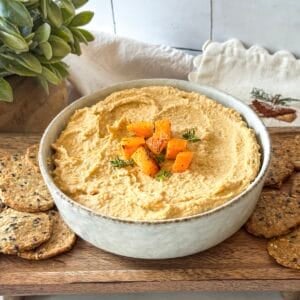
Creamy Butternut Squash Hummus with Roasted Garlic
Equipment
- 1 food processor (or high speed blender)
Ingredients
- 2 cups butternut squash, diced
- 1 bulb garlic
- 1 tablespoon fresh thyme leaves
- ¾-1 teaspoon kosher salt, divided (more to taste)
- ¼ teaspoon black pepper
- 3 tablespoon extra virgin olive oil, divided
- 1 (15 oz) can chickpeas, drained and rinsed
- 2 tablespoon tahini
- 2 tablespoon lemon juice
- 1 teaspoon pure maple syrup
- ½ teaspoon ground cinnamon
- ¼ teaspoon ground cumin
- 2 tablespoon water (more as needed)
- 2-3 ice cubes, added at the end (optional)
Instructions
- Preheat the oven to 400℉ (200°C). Prepare a baking sheet with parchment paper sprayed with cooking spray for easy clean up. Cut the top end off the bulb of garlic.
- Add the butternut squash, garlic (cloves facing up), 1 tablespoon olive oil, 1 tablespoon fresh thyme, ¼ teaspoon kosher salt, ¼ teaspoon black pepper. Toss everything to combine, making sure the garlic is coated in olive oil. Roast for 20-25 minutes until the squash is fork tender.
- Drain and rinse the chickpeas. Once the butternut squash is done roasting, let it cool at least 10 minutes. Add the butternut squash and garlic to a food processor or blender. *To add the garlic cloves, carefully squeeze them out of the skin being careful not to get the skins in the food processor or blender. Add the remaining ingredients except the ice cubes, starting with ½ teaspoon kosher salt.
- Blend the mix ~2-3 minutes until smooth, using a spatula to push down the sides as needed. Add 1-2 more ice cubes at the end of blending to give it a more creamy texture. Give it a taste and add more salt, water, or an extra drizzle of olive oil as needed.
Video
Notes
- For ease, I suggest using a squeezable tahini - it's easier and less messy than getting it out of a jar. But be sure to shake it very well!
- For best flavor, use freshly squeezed lemon instead of lemon juice from the bottle.
- To save time, use canned chickpeas. I do not recommend using unsalted chickpeas unless you are watching your sodium levels for a medical reason.
- If you prefer a thinner consistency, add a little bit of the aquafaba (chickpea liquid from the can) or more water to thin it out more.
- Refrigerator - Store leftover hummus in an airtight container in the fridge for up to 3-4 days.
- Freezer - hummus will be good in the freezer for up to 4 months in a freezer-safe container. Add a bit of olive oil to the top of the hummus before freezing. This will help it keep the moisture locked in.
- To Thaw - thaw frozen hummus in the refrigerator overnight. To get it back to its creamy consistency, use a spoon to whip it and add a bit more olive oil as you stir before serving.

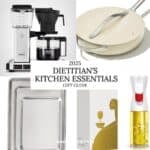

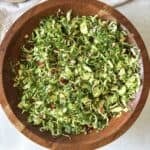
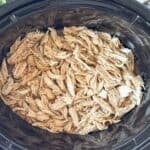
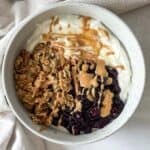
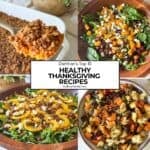
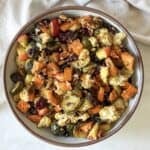


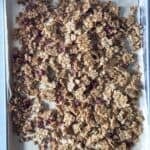
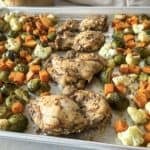
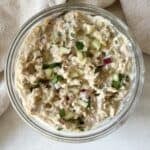
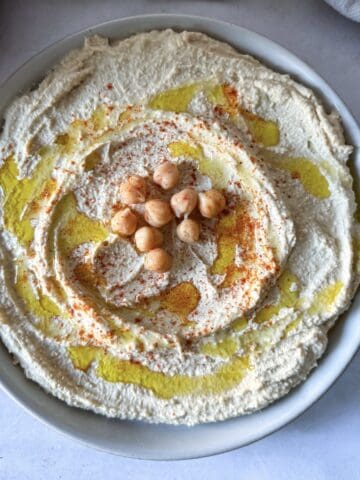
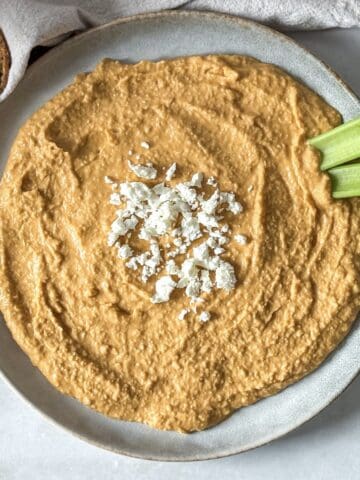
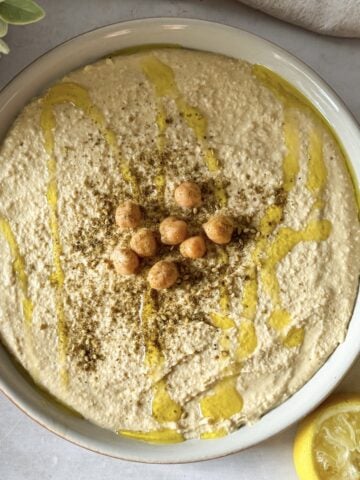
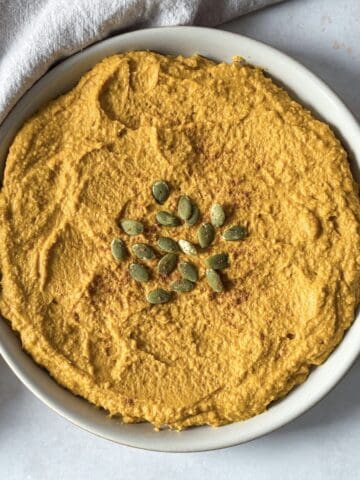
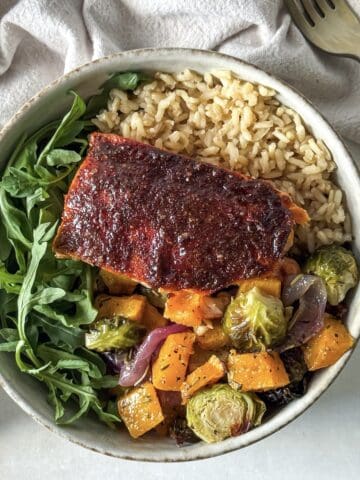
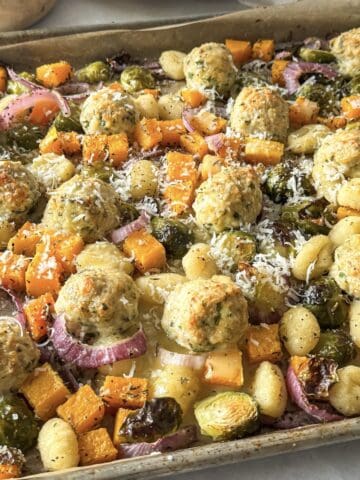
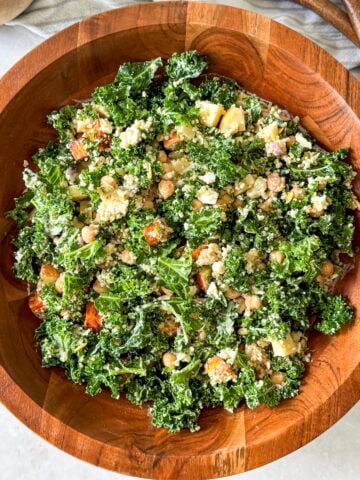
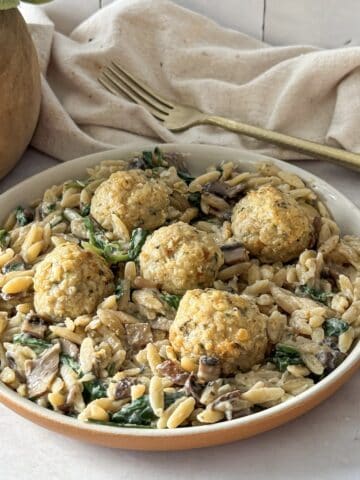
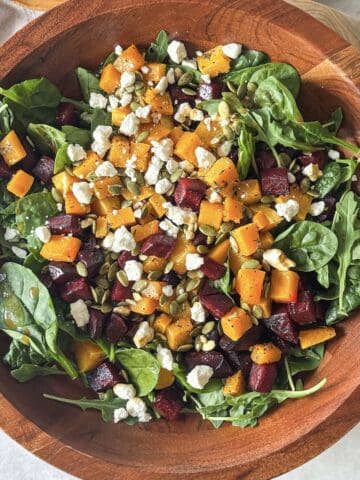
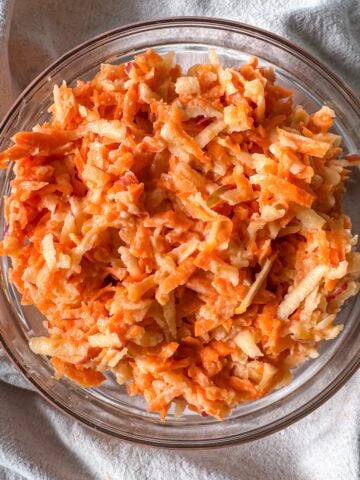
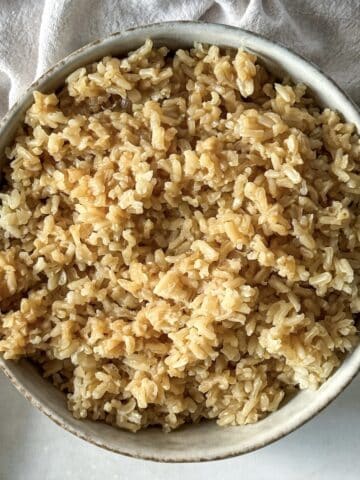
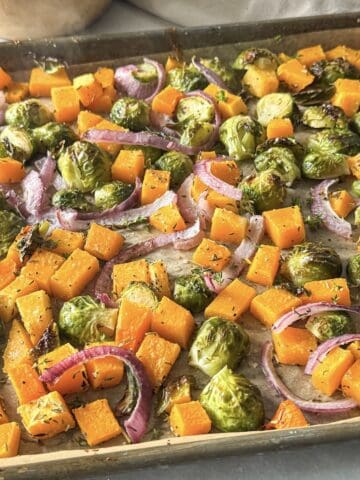
Comments
No Comments